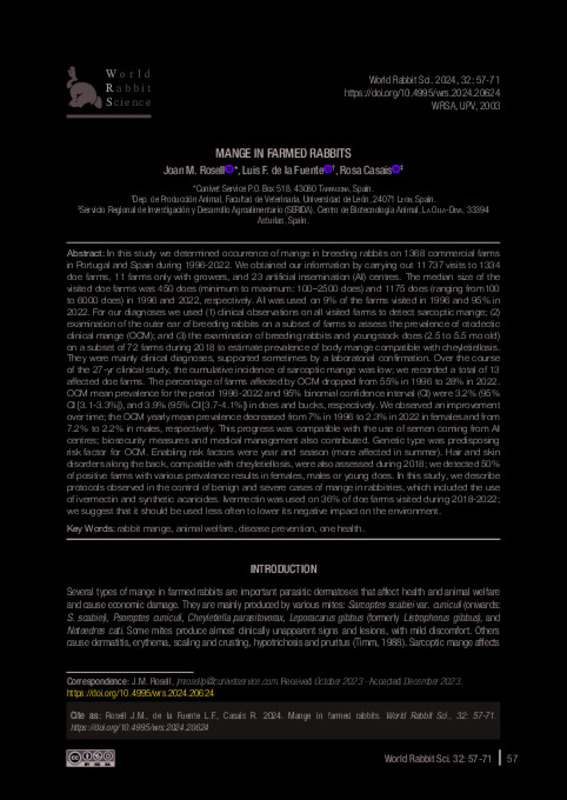|
Resumen:
|
[EN] In this study we determined occurrence of mange in breeding rabbits on 1368 commercial farms in Portugal and Spain during 1996-2022. We obtained our information by carrying out 11 737 visits to 1334 doe farms, 11 farms ...[+]
[EN] In this study we determined occurrence of mange in breeding rabbits on 1368 commercial farms in Portugal and Spain during 1996-2022. We obtained our information by carrying out 11 737 visits to 1334 doe farms, 11 farms only with growers, and 23 artificial insemination (AI) centres. The median size of the visited doe farms was 450 does (minimum to maximum: 100 2500 does) and 1175 does (ranging from100 to 6000 does) in 1996 and 2022, respectively. AI was used on 9% of the farms visited in 1996 and 95% in 2022. For our diagnoses we used (1) clinical observations on all visited farms to detect sarcoptic mange; (2) examination of the outer ear of breeding rabbits on a subset of farms to assess the prevalence of otodectic clinical mange (OCM); and (3) the examination of breeding rabbits and youngstock does (2.5 to 5.5 mo old) on a subset of 72 farms during 2018 to estimate prevalence of body mange compatible with cheyletiellosis. They were mainly clinical diagnoses, supported sometimes by a laboratorial confirmation. Over the course of the 27-yr clinical study, the cumulative incidence of sarcoptic mange was low; we recorded a total of 13 affected doe farms. The percentage of farms affected by OCM dropped from 55% in 1996 to 28% in 2022. OCM mean prevalence for the period 1996-2022 and 95% binomial confidence interval (CI) were 3.2% (95% CI [3.1-3.3%]), and 3.9% (95% CI [3.7-4.1%]) in does and bucks, respectively. We observed an improvement over time; the OCM yearly mean prevalence decreased from 7% in 1996 to 2.3% in 2022 in females and from 7.2% to 2.2% in males, respectively. This progress was compatible with the use of semen coming from AI centres; biosecurity measures and medical management also contributed. Genetic type was predisposing risk factor for OCM. Enabling risk factors were year and season (more affected in summer). Hair and skin disorders along the back, compatible with cheyletiellosis, were also assessed during 2018; we detected 50% of positive farms with various prevalence results in females, males or young does. In this study, we describe protocols observed in the control of benign and severe cases of mange in rabbitries, which included the use of ivermectin and synthetic acaricides. Ivermectin was used on 36% of doe farms visited during 2018-2022; we suggest that it should be used less often to lower its negative impact on the environment.
[-]
|









